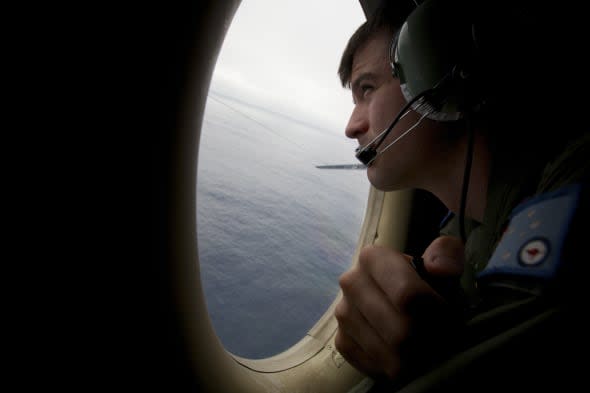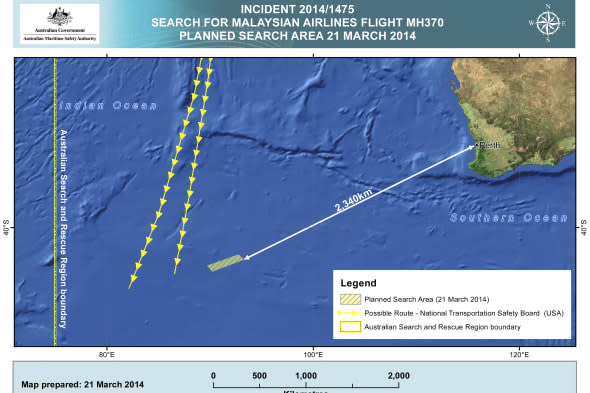MH370: 'Human input' is the only explanation says Boeing expert

Malaysian Airlines flight MH370 could not have ended up over the southern Indian Ocean by itself, and its plight can only be explained by the action of a human or humans, says a veteran Boeing 777 captain.
Commenting on the online airline safety rating site AirlineRatings.com, the pilot who as a check captain would have been responsible for checking pilot flight standards said said: "We are not dealing with an out-of-control plane. It is impossible for the Boeing 777 to fly this course by itself." Source: Press Association.
He went on: "To change course requires the pilot to either disengage the flight management computer and dial in a new heading to the autopilot/flight director or fly manually."
Commenting on reports that the plane apparently increased its altitude to 45,000ft before descending as low as 5,000ft, he said: "This would have required input to reselect altitude in the autopilot/flight director or manually to fly the plane and typically reduce engine thrust."

MH370 then apparently made two more turns - the first to the north west and then due south.
According to the check captain, the 777 would have had to climb back to its cruising altitude of 35,000ft because it would never have reached the southern Indian Ocean with the fuel load it had.
He said: "At say 12,000ft it burns eight tons of fuel an hour but we can only fly at a top speed of 340 knots (about 390mph). But at 35,000ft we would burn seven tons of fuel an hour and fly at 480 knots."
When MH370 ran out of fuel and if no one was in control, the Boeing 777 would not have glided down slowly, according to the check captain.
He said: "With no engine power and no one flying it would have gone into a spiral and straight down, possibly reaching supersonic speeds. Parts would have started to break off."
However, within a minute of the engines quitting, the plane's auxiliary power unit in the tail, with its own fuel supply, would have started automatically and brought power back to the electrical systems.
AirlineRatings said this might account for the final partial ping from the plane picked up by Inmarsat at 8.19am local time.
No response was received from the plane at 9.11am, when the ground earth station sent the next log on/log off message or ping. This indicates that the plane was no longer logged on to the network and is consistent with the limit.
This indicates that the plane was no longer logged on to the network and is consistent with the limit of its range with its fuel load.
The check captain said all the course changes could have all been programmed at the same time but the altitude changes could not.
The course taken by Malaysia Airlines flight MH370 could only have involved "human input", according to a veteran Boeing 777 captain.

It would have been impossible for the airline to have ended up over the southern Indian Ocean "by itself", said the pilot who as a check captain would have had responsibility for checking pilot flight standards.
His comments were made to online airline safety rating site www.AirlineRatings.com.
The check captain said: "We are not dealing with an out-of-control plane. It is impossible for the Boeing 777 to fly this course by itself."
He went on: "To change course requires the pilot to either disengage the flight management computer and dial in a new heading to the autopilot/flight director or fly manually."
Commenting on reports that the plane apparently increased its altitude to 45,000ft before descending as low as 5,000ft, he said: "This would have required input to reselect altitude in the autopilot/flight director or manually to fly the plane and typically reduce engine thrust."
MH370 then apparently made two more turns - the first to the north west and then due south.
According to the check captain, the 777 would have had to climb back to its cruising altitude of 35,000ft because it would never have reached the southern Indian Ocean with the fuel load it had.
He said: "At say 12,000ft it burns eight tons of fuel an hour but we can only fly at a top speed of 340 knots (about 390mph). But at 35,000ft we would burn seven tons of fuel an hour and fly at 480 knots."
When MH370 ran out of fuel and if no one was in control, the Boeing 777 would not have glided down slowly, according to the check captain.
He said: "With no engine power and no one flying it would have gone into a spiral and straight down, possibly reaching supersonic speeds. Parts would have started to break off."
However, within a minute of the engines quitting, the plane's auxiliary power unit in the tail, with its own fuel supply, would have started automatically and brought power back to the electrical systems.
AirlineRatings said this might account for the final partial ping from the plane picked up by Inmarsat at 8.19am local time.
No response was received from the plane at 9.11am, when the ground earth station sent the next log on/log off message or ping. This indicates that the plane was no longer logged on to the network and is consistent with the limit.
This is consistent with the limit of its range with its fuel load.
The check captain said all the course changes could have been programmed at the same time but the altitude changes could not.
Related articles
MH370 and other aviation mysteries




